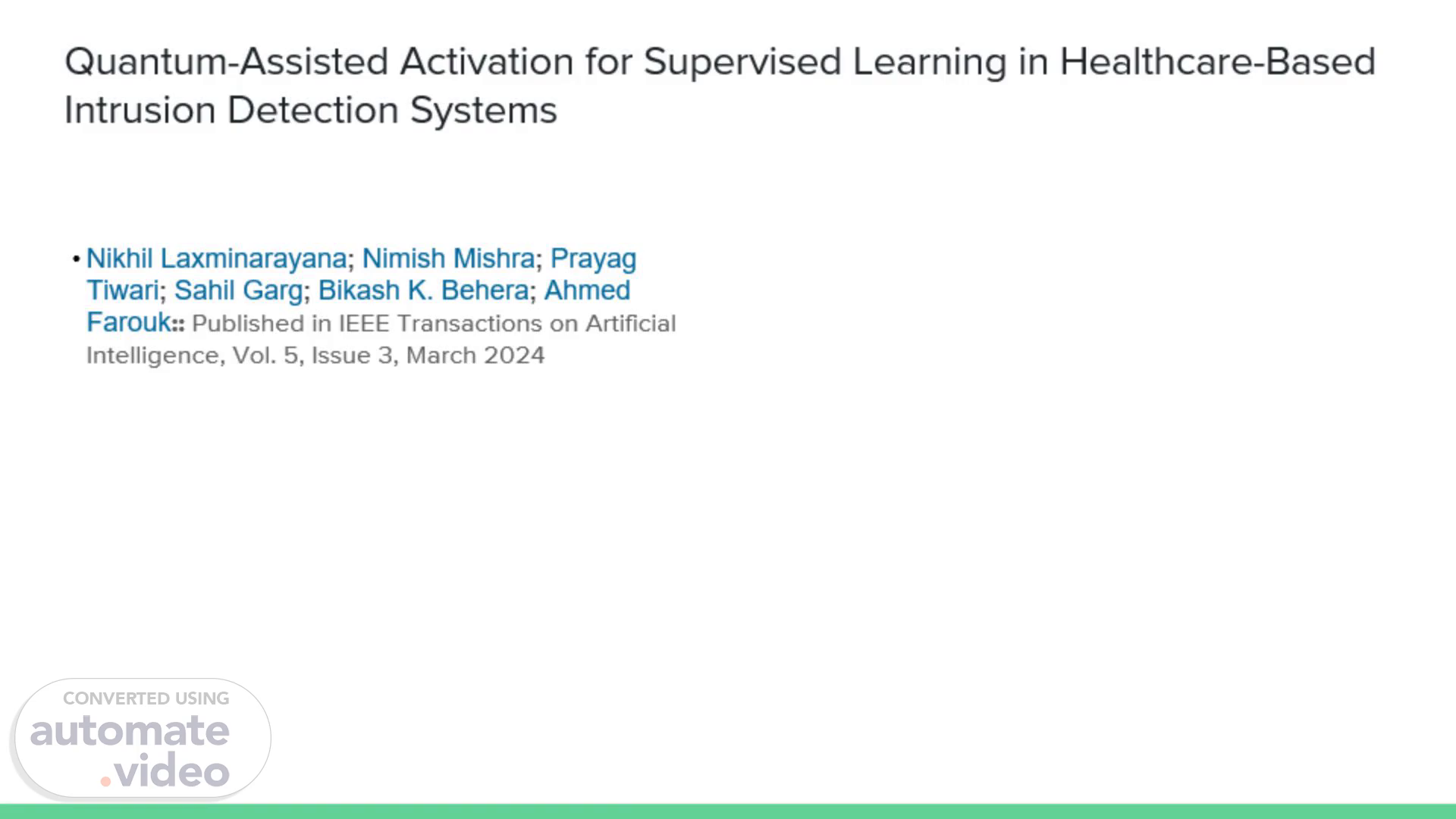
Page 1 (0s)
[Audio] In this video, we present a research work entitled "Quantum-Assisted Activation for Supervised Learning in Healthcare-Based Intrusion Detection Systems". This is published in IEEE Transactions on Artificial Intelligence, vol. 5, issue 3, March 2024. From the title, it is clear that a quantum-assisted activation function is proposed for supervised learning and applied to healthcare-based intrusion detection systems. Let us proceed to the next slide and discuss it in detail..
Page 2 (35s)
[Audio] An Intrusion Detection System (IDS) is a security mechanism that monitors network or system activities for malicious actions or policy violations and generates alerts when such activities are detected. This is crucial for protecting sensitive healthcare data and defending against network breach attacks. Though traditional machine learning algorithms are integrated and applied to the IDS, they face challenges in dealing with large and complex datasets, which leads to high computational costs. To solve these issues, quantum algorithms can be used that can process large and complex datasets efficiently..
Page 3 (1m 15s)
[Audio] In this work, the key innovation is the development of a quantum-assisted activation function. This simplifies the neural network architecture and maintains high accuracy and performance. The proposed mechanism combines quantum mechanics principles with neural networks. Here, the expectation value acts as the activation function given in equation (6). Here, the Z tensor n is the application of Z operations on each qubit, and the state phi is given as the serial application of two unitary operations Uw and Ux on the psi state..
Page 4 (1m 54s)
[Audio] This is one of the proposed architectures that is used as the hybrid classical-quantum neural model. It integrates quantum-assisted activation functions and captures patterns efficiently, reducing memory and computational costs..
Page 5 (2m 10s)
[Audio] Here is the experimental set-up. A benchmark dataset, KDD99, is used as the IDS system. Google colab is used as the coding platform. Tensorflow Keras library packages are used, and the experiment is performed using the Qiskit programming language. For the experiment on the dataset, accuracy is used as the evaluation metric, which is compared between both proposed and existing works..
Page 6 (2m 39s)
[Audio] The loss and accuracy plot is shown for the first architecture. It can be observed that with an increase in epoch, the accuracy starts at around 0.75 and slowly increases and stays constant below 1.0. The loss function also starts at 0.5, decreases to below 0.25 just after the second epoch, and then continues to decrease slowly. A total of 14 epochs are taken, as after that, both loss and accuracy values saturate..
Page 7 (3m 10s)
[Audio] Here is the proposed second architecture. The quantum advantages of the proposed architectures are the simplified neural network architectures, which reduce the risk of overfitting and lower memory and computational costs. The training and deployment process is also easier..
Page 8 (3m 28s)
[Audio] In summary, an innovative approach using quantum-assisted activation function is proposed. It enhances efficiency and accuracy in IDS for healthcare and thus promises solutions for improving cybersecurity systems. In the table, the accuracies of both the proposed architectures and other existing works are compared. It can be noted that other classical algorithms, such as LSTM, RNN, and CNN, have already achieved more than 99% accuracy. The proposed architecture also achieved a similar level of more than 99% accuracy. Hence, the proposed architecture is a promising tool, as greater and similar accuracy is achievable with lower computational cost..
Page 9 (4m 12s)
[Audio] For further reading, please refer to the full paper, whose link is given on the screen..
Page 10 (4m 27s)
[Audio] Thank you for watching this video. If you have any questions, please feel free to contact me via the given email address..